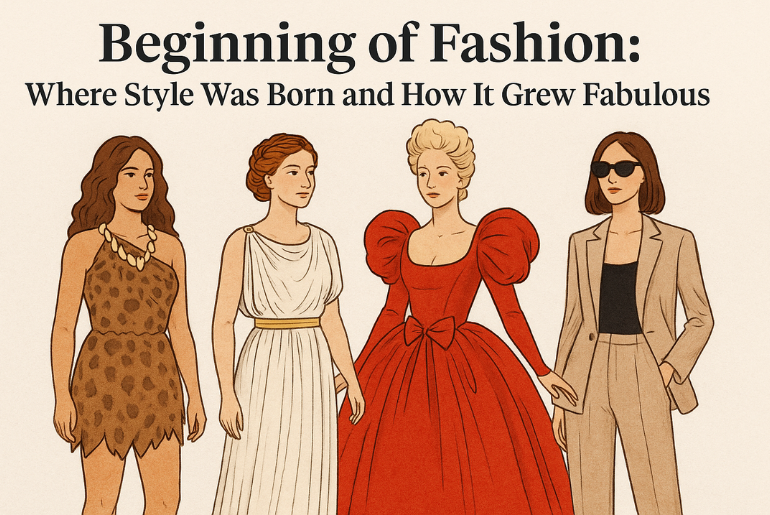
From fig leaves to fashion week—this glow-up deserves its own runway.
Once upon a fabulous time, before labels, hashtags, or “What Are You Wearing?” red carpet interviews… there was a leaf. Not the metaphorical kind—an actual leaf. Someone, somewhere in prehistoric history, decided to stop being naked and start being notable. And just like that, fashion was born.
Let’s take a strut down memory lane and explore how style went from caveman couture to couture couture—and how every look we love today has roots in the most extra evolution story ever told.
Stone Age Slay: When Fashion Meant Survival (and Status)
Forget Balmain—early humans were out here draping themselves in animal hides like it was the fall/winter collection of 10,000 B.C. Clothes were practical at first (hello, hypothermia prevention), but let’s not pretend prehistoric folks didn’t enjoy a good fur-on-fur moment.
Early fashion flex: Shell jewelry, bone beads, and dyed hides. Proof that even our ancient ancestors wanted to accessorize. #StoneAgeChic
The Classics: Greek Drapes & Roman Runways
Fast-forward a few thousand years and the Greeks and Romans entered the scene like fashion influencers with fabric sponsorships. Linen and wool were the fabrics, and how you wore your toga or chiton said everything about your status.
Still trending today? Gladiator sandals, flowing silhouettes, and belted waists. Honestly, Zeus could’ve been a street style icon.
Royal Threads: Medieval Fashion and Renaissance Realness
In the Middle Ages, layering became an art. Nobility showed off with heavy brocades, fur trims, and enough fabric to carpet a palace. If you weren’t sweating in your velvet tunic, were you even important?
Then came the Renaissance: puffed sleeves, corsets, ruffles—and enough gold thread to bankrupt a kingdom. Fashion became fierce and a little frivolous (a.k.a. fabulous).
Hot trend of the 1500s: Big collars. Like, really big. You could land a pigeon on those things.
18th to 19th Century: Wigged Out and Cinched In
From Marie Antoinette’s gravity-defying hairdos to Regency-era empire waist gowns, fashion during this period was about drama, decadence, and the birth of true designer craftsmanship.
Cue the entrance: Charles Frederick Worth, often hailed as the first fashion designer. He was serving custom gowns to Parisian elite like he invented the word “bespoke” (he kinda did).
20th Century: The Runway Revolution
Coco Chanel gave us the little black dress. Dior cinched waists with the “New Look.” The 60s got mod, the 70s got disco, the 80s went big (shoulder pads, baby), and the 90s decided less is more. Fashion became a full-blown language, a rebellion, a moodboard of cultural moments.
Quick timeline of iconic slays:
- 1920s: Flapper fringe & pearls
- 1950s: Pin-up waistlines & polished glam
- 1970s: Bell-bottoms & boho babe energy
- 1990s: Minimalism meets MTV
Today: Style for the Scroll Era
Now, we live in a world where your outfit can go viral before you’ve even left the house. Fashion is digital, genderless, sustainable (we hope), and deeply personal. One minute you’re dressing like a ‘90s pop star, the next you’re in cottagecore with a side of Y2K.
But the roots remain the same: Fashion is expression. It’s identity. It’s armor. It’s art.
And it’s been that way since someone first looked at a leaf and thought, “Ugh, I need accessories.”
The Threads That Tie Us Together
The beginning of fashion wasn’t just about covering up—it was about standing out. And from ancient tribes to TikTok tribes, one thing has remained fierce and fabulous:
We dress not just to impress—but to express.
Ready to Create Your Chapter in Fashion History?
Why not shop the designer pieces that make your story unforgettable?
From modern classics to head-turning statements, Designer Treas is your time machine to style the past, present, and future.
